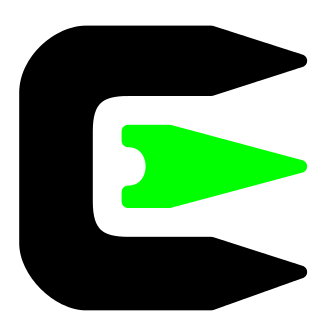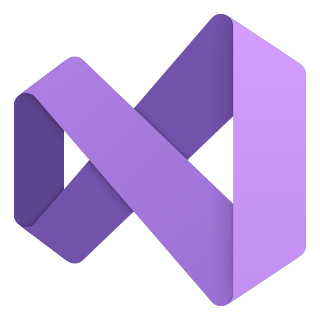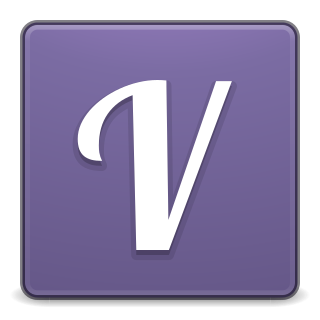
Cygwin is a Unix-like environment and command-line interface for Microsoft Windows. Cygwin's purpose is expressed in its motto: "Get that Linux feeling – on Windows".

Dylan is a multi-paradigm programming language that includes support for functional and object-oriented programming (OOP), and is dynamic and reflective while providing a programming model designed to support generating efficient machine code, including fine-grained control over dynamic and static behaviors. It was created in the early 1990s by a group led by Apple Computer.

Oberon is a general-purpose programming language first published in 1987 by Niklaus Wirth and the latest member of the Wirthian family of ALGOL-like languages. Oberon was the result of a concentrated effort to increase the power of Modula-2, the direct successor of Pascal, and simultaneously to reduce its complexity. Its principal new feature is the concept of type extension of record types. It permits constructing new data types on the basis of existing ones and to relate them, deviating from the dogma of strictly static typing of data. Type extension is Wirth's way of inheritance reflecting the viewpoint of the parent site. Oberon was developed as part of the implementation of an operating system, also named Oberon at ETH Zurich in Switzerland. The name is from the moon of the planet Uranus, named Oberon.

Microsoft Visual C++ (MSVC) is a compiler for the C, C++, C++/CLI and C++/CX programming languages by Microsoft. MSVC is proprietary software; it was originally a standalone product but later became a part of Visual Studio and made available in both trialware and freeware forms. It features tools for developing and debugging C++ code, especially code written for the Windows API, DirectX and .NET.

D, also known as dlang, is a multi-paradigm system programming language created by Walter Bright at Digital Mars and released in 2001. Andrei Alexandrescu joined the design and development effort in 2007. Though it originated as a re-engineering of C++, D is a profoundly different language —features of D can be considered streamlined and expanded-upon ideas from C++, however D also draws inspiration from other high-level programming languages, notably Java, Python, Ruby, C#, and Eiffel.
A cross compiler is a compiler capable of creating executable code for a platform other than the one on which the compiler is running. For example, a compiler that runs on a PC but generates code that runs on an Android smartphone is a cross compiler.
MinGW, formerly mingw32, is a free and open source software development environment to create Microsoft Windows applications.
Harbour is a computer programming language, primarily used to create database/business programs. It is a modernized, open source and cross-platform version of the older Clipper system, which in turn developed from the dBase database market of the 1980s and 1990s.

In software development, CMake is cross-platform free and open-source software for build automation, testing, packaging and installation of software by using a compiler-independent method. CMake is not a build system itself; it generates another system's build files. It supports directory hierarchies and applications that depend on multiple libraries. It is used in conjunction with native build environments such as Make, Qt Creator, Ninja, Android Studio, Apple's Xcode, and Microsoft Visual Studio. It has minimal dependencies, requiring only a C++ compiler on its own build system.
In computer programming, DLL injection is a technique used for running code within the address space of another process by forcing it to load a dynamic-link library. DLL injection is often used by external programs to influence the behavior of another program in a way its authors did not anticipate or intend. For example, the injected code could hook system function calls, or read the contents of password textboxes, which cannot be done the usual way. A program used to inject arbitrary code into arbitrary processes is called a DLL injector.
Classpath is a parameter in the Java Virtual Machine or the Java compiler that specifies the location of user-defined classes and packages. The parameter may be set either on the command-line, or through an environment variable.
A weak symbol denotes a specially annotated symbol during linking of Executable and Linkable Format (ELF) object files. By default, without any annotation, a symbol in an object file is strong. During linking, a strong symbol can override a weak symbol of the same name. In contrast, in the presence of two strong symbols by the same name, the linker resolves the symbol in favor of the first one found. This behavior allows an executable to override standard library functions, such as malloc(3). When linking a binary executable, a weakly declared symbol does not need a definition. In comparison, a declared strong symbol without a definition triggers an undefined symbol link error.
The Environment Modules system is a tool to help users manage their Unix or Linux shell environment, by allowing groups of related environment-variable settings to be made or removed dynamically.

Vala is an object-oriented programming language with a self-hosting compiler that generates C code and uses the GObject system.
Cobra is a discontinued general-purpose, object-oriented programming language. Cobra is designed by Charles Esterbrook, and runs on the Microsoft .NET and Mono platforms. It is strongly influenced by Python, C#, Eiffel, Objective-C, and other programming languages. It supports both static and dynamic typing. It has support for unit tests and contracts. It has lambda expressions, closures, list comprehensions, and generators.

FutureBasic is a free BASIC compiler for Apple Inc.'s Macintosh.
Dart is a programming language designed by Lars Bak and Kasper Lund and developed by Google. The programming language can be used to develop web and mobile apps as well as server and desktop applications.
Objective-C is a high-level general-purpose, object-oriented programming language that adds Smalltalk-style messaging to the C programming language. Originally developed by Brad Cox and Tom Love in the early 1980s, it was selected by NeXT for its NeXTSTEP operating system. Due to Apple macOS’s direct lineage from NeXTSTEP, Objective-C was the standard programming language used, supported, and promoted by Apple for developing macOS and iOS applications until the introduction of the Swift programming language in 2014.

Nim is a general-purpose, multi-paradigm, statically typed, compiled high-level systems programming language, designed and developed by a team around Andreas Rumpf. Nim is designed to be "efficient, expressive, and elegant", supporting metaprogramming, functional, message passing, procedural, and object-oriented programming styles by providing several features such as compile time code generation, algebraic data types, a foreign function interface (FFI) with C, C++, Objective-C, and JavaScript, and supporting compiling to those same languages as intermediate representations.
eC is an object-oriented programming language, defined as a super-set of the C language.







